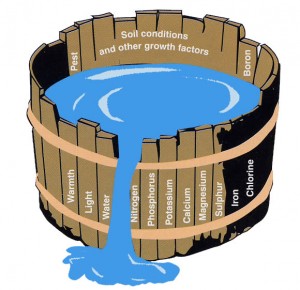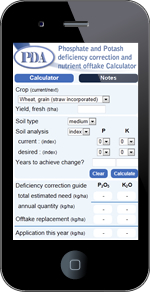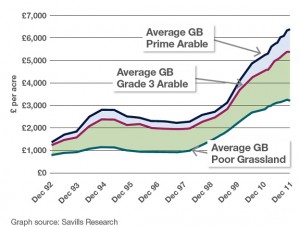Download pdf: What are the effects of potash deficiency? (723.62K)
pdf 723.62K
What are the effects of potash deficiency?
March 2013

We write ‘effects of potash deficiency’ rather than ‘symptoms of deficiency’, because so many of the negative effects of a shortage of available potash to crops are not clearly apparent, whereas ‘symptoms’ implies some visible effect. Of course severe deficiency has visible symptoms (Figure 1), but there can be many expensive negative impacts on the crop well before clear symptoms are seen.
Because most crops contain considerably more potassium than nitrogen or other nutrients, it might be expected that potassium deficiency would be the most commonly seen. However the majority of the potassium in crop tissues is supplied from the reserves in the soil, with relatively little coming from freshly applied fertiliser – in contrast to nitrogen or sulphur. Problems begin to arise when these soil potassium reserves are insufficient, usually as indicated by soil analysis results of K Index 0 or 1.
Not only must the soil be able to provide the large amount of potassium required by the growing crop – in excess of 300 kgK2O/ha for the wheat crop data shown in Figure 2 – it must also be readily available so that the high daily uptake requirement in the spring can be met.
A crop has the simple objective of producing some seeds so that it survives into the following season. It does not feel an obligation to produce an 8-10 tonne yield, and it will produce some offspring even if nutrient availability is less than ideal. It will probably not show any symptoms of a sub-optimal potash supply, but will simply produce a smaller yield.
We do not apply fertilisers to make crops grow, but rather to remove any nutritional limitations to achieving their genetic yield potential. We can force animals to eat more than they need and to become over-fat (or even voluntarily do it ourselves!), but we cannot force crops to eat. The skill of the grower and adviser is to ensure that none of the essential nutrient requirements of the crop is in short supply (or ‘deficient’ from our high yield perspective), so that the crop can reach its full potential subject to non-nutritional constraints. However we cannot rely on the crop to tell us by visible symptoms when it has a less than ideal supply of available potash; it will usually manage with what it has to its own satisfaction. Soil analysis will tell us whether the potash supply is likely to be adequate for full yield expression or whether there is the possibility of deficiency.
Lower yields than expected.

Unlike animals, which can substitute another form of food if a preferred one is unavailable, plants must have all their mineral nutrients available to them. There is almost no possibility of substitution. Thus if one nutrient is in short supply crop growth is inhibited, as has been well illustrated by ‘Liebig’s barrel’.
Potassium is essential for the proper functioning of many processes within plants:
- Essential for shoot and root tip (meristem) growth. Potassium-deficient plants show poor growth rates, due not only to the direct importance of K+ to the production of new cells but also to its positive effect on growth-stimulating plant hormones.
- Essential for cell extension. Cell extension involves the formation of a large central vacuole occupying 80-90% of the cell volume. The solution (sap) in the vacuole requires K+ to create the osmotic potential which draws water into the expanding cell. A shortage of available potassium will inhibit not only the production of cells but also their expansion, i.e. in inhibits biomass production.
- Essential for managing the water status of crops. Potassium affects the uptake and movement of water in the plant and has a major influence on the opening and closing of the stomata. These stomatal openings, mostly in the leaves, allow the evaporation of transpiration-stream water from the leaves (with a cooling effect in summer) and the intake of carbon dioxide from the air for photosynthesis. A deficiency of potassium can have a large effect on the overall water-related efficiency of the plant, and makes it more susceptible to drought stress.
- Essential for photosynthesis. Potassium deficiency can depress the rate of photosynthesis, potentially halving the availability of the carbon dioxide necessary for conversion to carbohydrate.
- Essential for the translocation of photosynthates. Potassium plays a critical role in the transport of carbohydrates and proteins from the leaves and into storage organs such as grain. Thus a shortage of K+ not only inhibits the productivity of the plant, it then also reduces the amount of carbohydrate and protein being translocated into harvestable yield.
These are some of the main functions of potassium in the plant; a shortage can have many and various effects, but in the final commercial analysis the main effect is a reduction in yield. If such a loss in potential yield occurs without visible symptoms of potassium deficiency, it is easy, but probably incorrect, to attribute it to weather effects or disease pressure, etc. Table 1 is taken from the recent Newsletter which introduced the PDA Calculator and indicates the possible yield losses which can occur from nutrient deficiency.
Table 1: Potential financial implications for an 8.8 t wheat crop on nutrient deficient soils.
| Bottom of Index 1 | Top half of Index 0 | |||
| Yield reduction vs. soil at Index 2 |
Income lost per year, wheat grain @ £175/t |
Yield reduction vs. soil at Index 2 |
Income lost per year, wheat grain @ £175/t |
|
| Phosphorus | 0.25 t/ha | £44/ha | 0.75 t/ha | £131/ha |
| Potassium | 0.7 t/ha | £131/ha | 1.3 t/ha | £227/ha |
There are many instances of poor establishment of crops sown last autumn, and while the main reason is no doubt less-than-ideal seedbeds and subsequent cold wet soils, the effect of these factors is made worse by low soil reserves of potassium, and also of phosphate. We have mentioned above the need for an adequate supply of potassium for shoot and root tip growth; early seedling growth is also particularly limited by a lack of available phosphate, especially in cold soils. There is little doubt that seedbed-applied phosphate and potash, particularly when combine drilled or placed, are particularly beneficial in difficult seasons; if soil nutrient indices are maintained close to the response limit it is likely that such applications will be cost-effective in all seasons.
PDA Calculator for estimating nutrients needed to correct soil deficiency.
 In the previous Newsletter the new PDA Calculator was introduced and there have been many reports of its usefulness both as a simple calculator of crop nutrient offtake and requirements for deficiency correction, and also as a stimulus for discussion on soil nutrient management. It can be found on the PDA website at: www.pda.org.uk/pda-app/
In the previous Newsletter the new PDA Calculator was introduced and there have been many reports of its usefulness both as a simple calculator of crop nutrient offtake and requirements for deficiency correction, and also as a stimulus for discussion on soil nutrient management. It can be found on the PDA website at: www.pda.org.uk/pda-app/
The Calculator can be used on the website and also downloaded to iPhones, iPads, android devices and Blackberries and then used without internet connection. All download guidance is on the website. We are always pleased to receive feedback from users.
The main feature of the Calculator is that it not only provides guidance for quantities of phosphate and potash needed for offtake replacement (maintenance) but it also allows estimation of nutrient quantities which may be required for deficiency correction. Importantly it shows the two estimates separately so that the offtake can be charged to the crop and the correction to a separate account. There is full flexibility of the target Index or mg/l for both nutrients, and full choice of timescale.
Land prices and fertility management.
 As assets become more valuable it is usual to take even more care over maintaining them in good condition. This is especially the case where these assets are still expected to perform all their original functions despite their increasing worth, as is the case with this venerable ERA, Bugatti etc seen still racing at Goodwood.
As assets become more valuable it is usual to take even more care over maintaining them in good condition. This is especially the case where these assets are still expected to perform all their original functions despite their increasing worth, as is the case with this venerable ERA, Bugatti etc seen still racing at Goodwood.
The appreciating asset in daily use and with which we are perhaps more familiar is agricultural land. As is shown in Figure 3, the price of farm land in Britain has been rising steeply in recent years. Not only are land prices increasing, but the gap between the price of the best and ‘the rest’ is widening. It is clearly important to ensure that the quality of valuable land does not deteriorate, but the British Survey of Fertiliser Practice (BSFP) continues to show a potentially serious imbalance between the phosphate and potash inputs and harvested offtakes for combinable crops, especially in England.

The PAAG soil sample analysis report for 2011/12 indicates that 23% of arable soils and 38% of grassland soils were at P Index 0 or 1, and that 31% of arable soils and 42% of grassland soils were at these low Indices for K. These data imply that increasingly valuable farmland soils are not always being well managed. While the eventual result will be a loss of asset value, the immediate effect is a reduction in yield and an inefficient use of other inputs such as nitrogen.
At a recent meeting in the USA, Dr Paul Fixen, director of research for the International Plant Nutrition Institute (IPNI), has made the same points about the situation in the maize belt in the US. He made the comment: “It’s a good time to remind ourselves that crops obtain much of the nutrients they absorb not from the fertilizer we apply this year, but from nutrients in the bulk soil and so the fertility level of that bulk soil is critically important.”
He concluded by introducing the concept of ‘restorative agronomy’. He suggested that there appear to be three approaches to phosphate and potash practices for the management of fertility, productivity and asset value of soil:
- A mining agronomy that leaves the soil and the resource base worse off.
- A minimalist agronomy that maintains the status quo but leaves the resource base vulnerable to extreme situations.
- A restorative agronomy which rebuilds the resource base to make it more resilient to extreme situations.
“As the dollar value of land increases, it seems that these terms should be front and center in our minds and plans made to assure that what we practice is indeed a restorative agronomy.”

